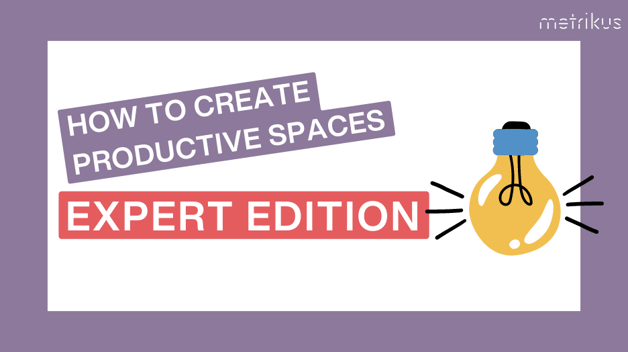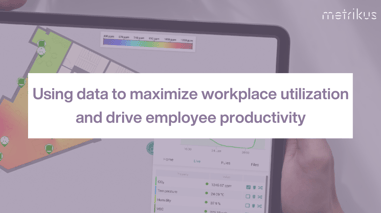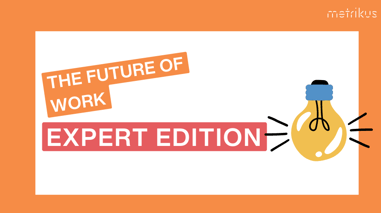How to create productive spaces | According to the experts
Productivity changes from person to person, but there are some factors that help us all to work more effectively.
Here at Metrikus, we talk a lot about the importance of good indoor air quality, but there are lots of other things to consider – from noise and color, to rituals and zoning.
Below, we’ve included four articles from our annual magazine, The Measure, where industry experts share their tips for boosting workplace productivity.
Contents
- Navigating the office of the future – Tony DiBenedetto, CEO at Appspace
- Designing along a spectrum of noise: Getting more out of smaller spaces – Stefanie Sebald, Head of Design at Kitt
- In the zone: How color can transform the spaces we work in – Emma Bestley and John Stubbs, co-founders of YesColours
- Staying focused and managing distractions, wherever you’re working – Laila Datoo, Workplace Wellbeing Expert, Mindfulness Trainer at a.life.more.mindful
Navigating the office of the future
Tony DiBenedetto, CEO at Appspace

Employee work experience is everything right now. Clear communication across all worker types – hybrid, remote, in-office, and frontline, is vital. Tony DiBenedetto, CEO at Appspace, walks us through a connected communications blueprint.
When the global pandemic shifted workplace dynamics, organizations and employees scrambled to navigate new work realities and routines. Once the economy started to recover and return to ‘normalcy,’ productivity paranoia crept in, with many managers finding it difficult to gauge their teams’ productivity without physical presence and cues.
New ways of working also reoriented employee expectations and priorities, such as a desire for improved internal communications and greater flexibility. Employees now want HR policies and tools to reflect today’s workplace realities in ways that best support their physical and mental wellbeing while driving team engagement. Organizations must balance these new employee expectations with the need to remain competitive in the marketplace.
Shift to outcome-based goals
More organizations are starting to connect employee satisfaction with company success and taking the necessary steps to meet market demand. In fact, many organizations are increasing hybrid schedules that accommodate employee work preferences, while ensuring company goals are met. By shifting the focus from quantitative metrics, like time spent on a task, to qualitative metrics, such as the quality of ideas, the equation between employees and their managers becomes more about collaboration and trust — even in hybrid settings.
Design spaces with a purpose
At the same time, organizations can strive to make the workplace more productive for employees working from office buildings. To maximize their in-office time, employees want environments that enhance collaboration. Therefore, hybrid workspaces must be designed thoughtfully to inspire productivity and team engagement.
Hardware purchases should meet the realities of what works best for today’s workplace. Employers also should weigh the pros and cons of purchasing decisions regarding cloud services, collaborative online workspaces, and internet connectivity options. Cost savings are always a consideration; however, organizations must ensure employees have the tools and technology they need to remain productive.
Tap technology to encourage productivity and create connections
Companies can achieve a lot with the right combination of technology and planning. Technology provides incredible avenues to enhance employee experience and unlock higher productivity levels. Here are a few specific strategies for using technology to create better workplace experiences for all employees:
- Start by making it easy for employees who no longer have an assigned office or desk to come into the workplace. Hot-desking and desk hoteling are increasingly common needs as organizations reduce their Real Estate footprints
- This is where space reservation technology can play a major role. Modern space reservation tools enable employees to see the office layout from their phones and book a preferred space. Employees can make their reservations before going into the office or even after they arrive. Having this flexibility allows employees to start their workdays without added stress
- Using digital signage in the right places helps keep teams connected and updated on important workplace news. Digital signage makes it possible to broadcast critical information, such as policy changes and safety guidelines to factory floors, warehouses, and other staff-only areas so that no one misses out on timely news
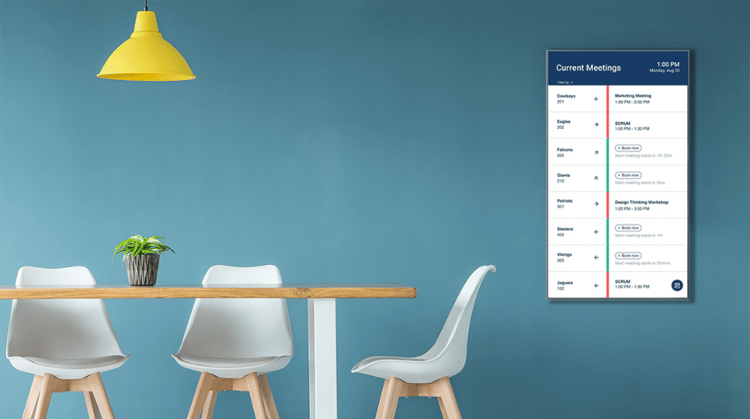
Meet employees where they are
Take the case of frontline employees who are mostly ‘deskless’ and often left out of the workplace communication loop. Given the nature of where they work, frontline workers may not have access to the same technology as their colleagues who work from traditional offices. In these instances, an employee app may be the most optimal solution to reach employees anytime and anywhere.
Use tools that work for HR and the business
The choice of tools and resources companies implement should consider everything from the industry's nature to the potential future setbacks. For instance, how do you ensure consistency in tools for a manufacturing business spread across multiple locations?
Listen and act on feedback
Employee feedback can provide valuable insights into what’s working for them and what’s not. It’s important this feedback exercise also addresses software and tools. Direct input from the technology end-users can unlock various possibilities, helping leadership better understand scalability and the potential for advanced integrations.
Designing along a spectrum of noise: Getting more out of smaller spaces
Stefanie Sebald, Head of Design at Kitt

Stefanie Sebald has worked as an architect and interior designer on a global scale in Europe, Australasia, and the United States on projects ranging from master plans, large scale and private high-end residential projects, as well as museum quality commercial interiors for retail, hotels, hospitality, and innovative workplace design. She now brings her design acumen to Kitt, the managed office provider.
The pandemic has changed a great deal when it comes to workspace. As hybrid work becomes the norm for businesses, the office is being used more often than not as a social hub – bringing people together for at least some of the week to break the tedium of working alone.
What that has created is a notion that all focus work is now done at home, while all collaborative work is saved for the office. And, while to an extent these patterns have emerged, a productive office space still needs to cater for both. It can be harder in smaller spaces, particularly on more social days where more people are in, but there are a few things you can begin to think about when it comes to your space.
Don’t eliminate focus spaces
I've never been able to collaborate for eight hours a day, or sometimes even up to 10 hours a day, however long in the office. When you’re going into the office for meetings, it’s not always collaboration time. I think everybody can relate to those days when you've got meeting after meeting; you’ve spent time before that doing the prep in order to really use that time well, and you then have a ton of work doing all the follow ups. It’s really exhausting!
So the trick is to allow for both. Of course you need collaboration spaces, but the flip side of that is that you also need focus spaces for getting heads-down work done. You need a place where people can make a phone call, or just sit and do a bit of work. All of these things occur daily, and are quite important to how people like (and need) to work, so don't just eliminate those areas.
Utilize a spectrum of noise when designing
One trick that we are using with some of our clients, particularly in smaller spaces, is to think about designing zones on a spectrum of noise rather than just for functionality. Think about which areas are being used for what purpose.
For example, if your kitchen also doubles up as a social space, it won’t make sense to position a meeting space next to it. Instead, you might think about putting another area where conversations are had, such as collaboration or ‘whiteboarding’ space.
Think of your space as a spectrum of noise, and make sure that focus areas such as desk space are far away from the louder corners of the office. Ultimately, you need to think about adjacencies and what makes sense.
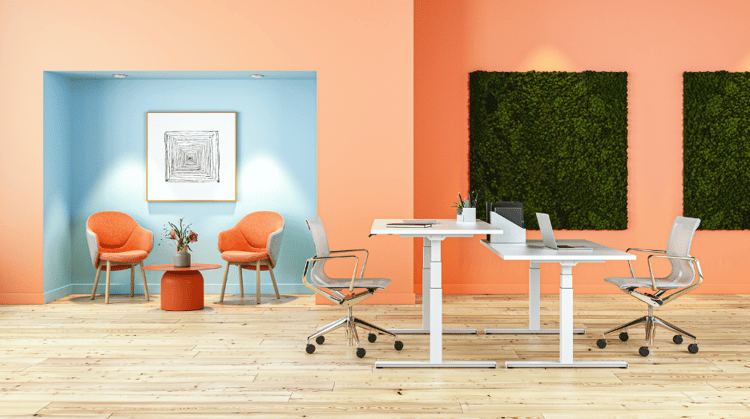
What to think about alongside design
It’s not always possible to have certain areas where you want them, particularly if you have less control over the physical layout of your space. With that in mind, the other important thing to consider is the structures and processes you put in place to enable a productive environment.
Space and the way you use it are so interlinked. It's important to have culture champions in your team who will make sure that, during the first month or two in a new space, that certain things are done a certain way. It could be as simple as making sure everyone puts away their plates after they eat, but if everybody does it then people will follow.
When it comes to how you use the space, and particularly with noise in mind, this could mean ensuring that loud conversations aren’t had during meeting hours – or when meeting rooms are being used. If a precedent is set, it becomes a little easier to facilitate a productive space for every type of working preference. Those little things you can’t design – they’re impacted by the culture, structures and processes.
Thinking about all of these things when it comes to designing your space will contribute to the working environment you create for your team. Workspaces are changing in response to new habits and preferences, but businesses still need to find a balance between areas for creativity and areas for focus.
In the zone: How color can transform the spaces we work in
Emma Bestley and John Stubbs, co-founders of YesColours

Throughout her career, Emma has been guided by an obsession with color and design, working for the World Culture Museum in Gothenburg, fashion buying, events and advertising agencies; BBDO, Ogilvy and Clear Channel. During his career, John has worked with renowned retail consultant and broadcaster, Mary Portas and delivered complex industrial design projects for global brands, including Westfield, Virgin, Panasonic and JosephJoseph.
First of all, we’d love to know how you got into the business of color!
Emma: I have synesthesia, so my brain associates colors with people and numbers. John actually once asked me what color I associate with him and it’s brown! Brown is a really earthy, grounded color and I think it's just something that human beings connect to as it feels more natural. Our friendship stems 20 years and has always been very honest down to earth.
In general in my synesthesia, browns are a good color. Thursday is brown and I love Thursdays! So there's a really lovely grounded exciting feel about it; John and Thursdays have got a very good, positive association.
Tuesdays, however, are a cold, cyan blue: I do not like Tuesdays!
Synesthesia is like a different language. 4% of the population has it – that’s over like 300 million people – but lots of people wouldn't even know they have it. Interestingly, there’s been research on this, and it only started in the late 90s, but if you have a certain type of synesthesia (like mine which is grapheme color synesthesia), you are eight times more likely to end up in a creative role or hobby; you’re just going to be drawn to it, there’s a path that you can’t really avoid.
What do you think is the most important strategy when it comes to using color in the workplace?
John: Zoning, for sure. I’ll use our work at Planes Studio as a case study. The interior designer there approached us purely on the basis that we were talking about color in a different way, talking about wellness, how you want to feel and room, how you want the rooms to be used.
A big part of this project was using pops of color in different areas. Zoning out areas, particularly in commercial spaces, is so, so important, because you want certain areas to be used in certain ways versus others. Crucially, color has a massive impact on how you feel in those spaces – you have to think about whether people need a space to feel calmer, or more productive.
In Planes Studio, we worked with interior designer, Alex Pepes and used Fresh Peach and Fresh Lilac in their boardroom paired with some original abstract art. We then used the more joyful, saturated pink pastels used in places where people were going to have meetings together, or in cubicles where people would be doing recordings or private calls (such as Joyful Pink).
You really have to think about the purpose of the room or area; after that, it’s about mixing and matching according to the space. It’s so important to us and the way that we work that we’ve organized our palette by these emotive objectives, so you have things like Calming Blue, Friendly Green, Serene Pink; we guide the customer to these groupings of colors according to how they want to feel in a room.
.png?width=750&height=420&name=Work%20from%20anywhere%20(2).png)
So what sort of colors should we be using in places where people are working?
Emma: When you have a few people in one space, it’s ideal to have a form of a warmer color, like a pink that is often seen as nurturing and bringing people together. Hues of orange can be really good for places where people are socializing or even where they need to focus for short bursts of time in a team.
Aside from research into what colors are good for workspaces, I think there’s a sense of energy in these pink and orange colors that doesn't drain you. And they’re not too intense (yellow for instance is sometimes a bit too intense), so it's that sort of safe zone on the color wheel where I think ignites some energy, or taps into a certain part of the brain.
I’ve actually just decorated my own office, and I’ve used our Friendly Peach; it’s got a Miami feel, a very vibrant pastel, because I really liked the warmth of it!
John: As well as that, I’ve worked in so many offices that have been painted this standard bright white. I find that very, very stark and almost overbearing on me, because I'm looking at my screen and then there's all this white around, and it's all like it's a bit of an assault on the senses.
Personally, I'm much, much better as a person at low light levels. I don't use the lights on the ceiling at home, so I've got little side lamps which makes things much softer and helps me to get the best out of my day in the way that I work. So for me, it’s about reducing those stark, bright colors, and bringing in the softer pastels.
Let’s say you have an office that’s painted white and you’re not able to do a total renovation – what are some low-effort, low-cost options to bring some color in?
John: As well as zoning, I'd also say accents can be a quick win. You can look at window bays, window sills, skirting boards; they’re all places where there can be an exciting little pop of color. I love it when you enter a room and it just looks all white, and you shut the door behind you and there’s a flash of electric yellow. That's what adds the fun into it!
A vibrant, bold color used sparingly can have a really great impact in a space. An example I love is that as part of the Habitat collaboration we did recently, the theme was Grounded Simplicity. What we did was paint a skylight our passionate olive green. I really don’t think people would usually think of doing just the skylight and even that color, but actually, as the light hits, it creates such a vibrant impression of the color; it elevated the space without dominating the room. The theme was all about keeping things minimal without being cold and I think that worked perfectly.
What else do you think about when you’re working on a new project?
John: The actual function of a space is so important. That's one of the reasons why we're developing the antimicrobial paints. When it comes to coworking, or commercial environments in general, you want it to be as healthy as possible in that environment. Helping to make people feel safe in their workspace goes hand in hand with the importance of making people feel how they need to feel in their workspace.
We’ve worked with places like hospitals, schools, mental health facilities, that have shown a huge interest in the impact of color, but also in keeping their occupants as safe as possible, so these antimicrobial features of paint can be part of their story of protecting their people.
Emma: We’re about to embark on a charity project in London, and they have this huge space that they use as a shelter, and it’s all about how the charity wants to use those spaces and how they want people to feel in them.
Again, color zoning is so, so important to that, even just as a way of denoting wayfinding in the space, letting people know to go to the yellow zone, or the green zone. It’s a practical thing for them to do to enable people to use the space slightly more easily.
And because it’s a homeless shelter, if you left it all white, it would just feel so clinical and not really welcoming. Where's the joy? Where's the personality? Instead, we want people to feel safe and comforted, so I think injecting color into a space like that is really vital for people's mental health and wellbeing.
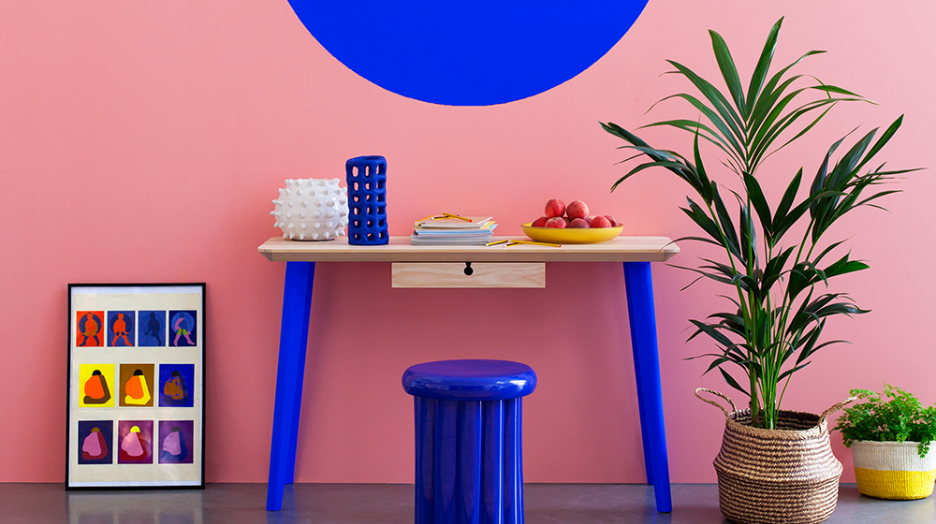
In places like coworking spaces or big offices where there’s lots of people coming together who all respond differently to external stimuli, what are some guiding principles on how you can choose colors?
Emma: When I was working in my previous career at Clear Channel, I was lucky enough that when it came to redecorating and choosing the colors, we all got to vote on it! That was so important as we were the ones who would have to sit and work in that space all the time, surrounded by the colors. It was a great way of collaborating with office management, and for us to realize that they actually care what we think.
Now I know that’s probably quite unusual, but it's not difficult to facilitate some discussion. Not everyone's gonna agree but then there's compromise there.
John: Certainly with commercial spaces and coworking spaces, the brand factor comes into it as well. In my former life doing interiors and working with big brands, I learned that it's important for a brand to not over-brand their spaces.
I’ll use Virgin as an example. Obviously the Virgin red is so strong, and it'd be easy just to drench everything in red. But instead, you need to create that little red thread that runs through everything that you touch. It was more about creating memorable moments throughout the journey of the space. So when you arrive, what's that moment where you cross that threshold into Virgin’s space? And what does that moment create for that customer or employee? And how does color, texture, and light come into that moment?
A really cool way to do this is by creating a color palette that hints towards the brand colors, rather than just being the brand colors. It's about injecting color in ways that doesn’t just dominate, but also has a brand function.
Going back to Plane Studios, if you look at their workspace and then go on their website and look at their branding, it makes total sense. I love that the use of color in their space isn’t just a cartoon version of their brand, you can see there’s a connection. If that’s done well, it’s a lovely detail to celebrate.
Staying focused and managing distractions, wherever you’re working
Laila Datoo, Workplace Wellbeing Expert, Mindfulness Trainer at a.life.more.mindful

Laila Datoo is a certified mindfulness and performance coach and created a.life.more.mindful to help well-intentioned but time poor business leaders and HR professionals to build happy, healthy and profitable workplaces. Laila has provided practical yet transformational solutions that have helped hundreds of professionals to beat stress and manage their mental health, from public sector organizations like the NHS and universities, to multinational corporates like Accenture and Hyatt.
What's the first thing you do when you sit down at your desk about to start work? Look at your to-do list? Check your emails? Scroll social media while you decide what to do first? Sit down and then get up to make a quick cup of tea?
It may feel like “easing into the day”, but these actions could be seriously distracting and, accumulated over the work day, can cost you hours of time, buckets of leaky energy and that all translates to lost money – whether directly or indirectly.
Whether you're working from home or back in the office, distractions are all around us.
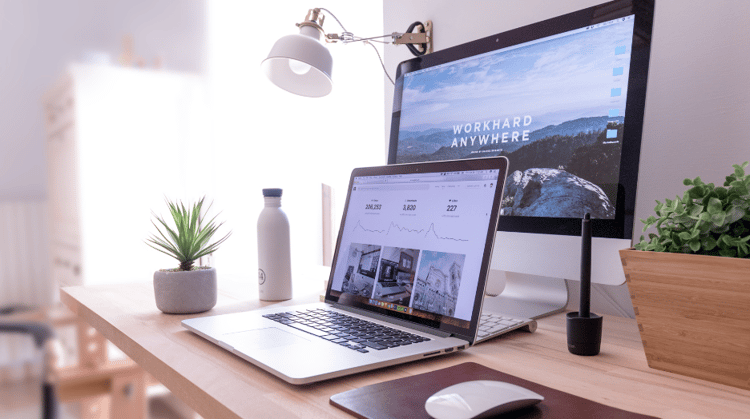
Distraction = procrastination = bad habit
You know that wonderful feeling called “flow state”? When you’re cruising along, ideas are flowing like warm chocolate, you’re in your power zone, killing your to-do list, feeling like a genius?
A 2015 study from UC Irvine shows that every single time you get interrupted, you get knocked out of your flow state. And then, after each disruption, it takes you approximately 23-30 minutes to fully re-enter your flow.
In other words, that “tiny little 3 second distraction” (a quick email check, a social media notification, an Amazon delivery knock at the door...) is actually a 30 minute setback.
Do you have 30 minutes to waste, numerous times a day? You most certainly do not!
How can you get more focused regardless of your environment and turn distractions into intentional welcome pauses?
Change your habits, focus your flow
- Be intentional about how you start your day
If you're in the office can you create a ritual to start the day like listening to a podcast or music on your commute.
WFH can look like creating a ritual to start your day like making a coffee, putting a certain playlist on or even lighting a candle.
You can also turn your WFH "commute time" into a positive way to start the day like exercise, reading, meditation so you don't go from bed to desk.
- Create the optimum environment
This is often the hardest one for people who struggle with being back in the office. Home can feel isolating and disconnected, while the office can be noisy and overwhelming. Take some time to work out what the optimum environment is for you to get your work done.
It could be things like:
- Listening to music when doing certain think-heavy tasks
- Perfecting the scents, lighting, views
- Tidying your desk
- Having collaboration close by
Then work out how you can achieve this no matter the environment. For example, if you work well with collaboration, set your office days for when colleagues are in so you can catch up. If you WFH, create an online collaboration space where you can co-work and co-create.
- Set a timer and focus your tasks
Organize your tasks into time blocks: if you have a big task to do, chunk it down into smaller tasks.
Decide how long your work sprints and then set a timer: 25 mins work and 5 min break can work well!
Decide what task comes first before you sit down. If you can, write your task list the night before so that when you sit down, you are clear what you're doing.
- Turn distractions into rewards
Instead of sitting down at your desk, procrastinating about where to start and then getting up to make a coffee/check the post/insert another distraction here, use those activities as a reward after your work sprint.
When you focus on what you need to do and you know you have a reward coming, it can help you knuckle down to get the task down.
Every few hours, schedule in a longer break – for lunch, exercise, a walk, an activity that can decompress your mind.
Put into place even one of the strategies and notice how your distracted moments reduce and your focused time increases. As with everything it’s about trial and error so try something out and see how it works for you.
Want to get more content like this? Check out ‘The Measure – Sizing Up PropTech, Commercial Real Estate and the Modern Workplace’, where these articles were originally printed.

